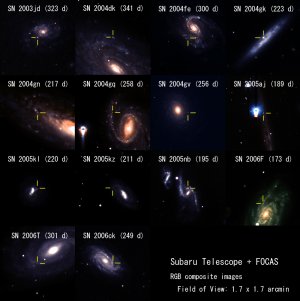|
|  |
Massive stars (more than 10 times the Sun) end their lives with a
bang. When their inner core collapses under its own gravity, energy is
released and the outer part of the star explodes as a
Supernova. Astronomers have not yet identified the process which turns
the collapse into the explosion. Various possibilities have been
proposed from the theoretical side (this is one of the main research
topics at MPA): It might be essential to break spherical symmetry, by
either hydrodynamic instability or stellar rotation, possibly via a
magnetic field. These scenarios should produce bipolar explosions.
Supernovae are usually discovered in external galaxies, and are too
distant for direct imaging of their geometry. Keiichi Maeda and Paolo
Mazzali worked on theoretical predictions which connect the geometry
of a supernova with an oxygen emission line profile in observed
spectra. They realized that "it is possible to derive the geometric
property of supernova explosions, by performing spectroscopy of a
supernova at late phases, more than about 200 days after the
explosion" (Figs. 1, 2). They proceeded to collect a large sample of
data in order to investigate the general properties of SN
explosions. In particular, they concentrated on Type Ibc SNe, which
are those explosions that disrupt massive stars that have lost their
outer hydrogen and helium shells before their core collapses. This
offers a more direct view of the deepest parts of the star, nearer the
site of collapse. Also, these SN are particularly interesting because
some of them, those with the highest energy, are sometimes connected
to Gamma-Ray Bursts (GRB).
The research team collected late-time spectra of 15 Type Ibc
supernovae using the 8m Subaru (operated by National Astronomical
Observatory of Japan) and VLT (European Southern Observatory)
telescopes (Fig. 3). This effort was soon to prove fruitful: one of
their early results was that the oxygen line can indeed show different
profiles: in the case of SN2003jd (Mazzali et al. 2003, Science) they
argued that they viewed an event similar to the GRB-Supernova 1998bw,
but which in this case was seen off-axis.
A large sample is essential in their investigation. While a variety of
profiles were observed from different SNe, it is difficult to
distinguish clearly between two cases - a spherical explosion and an
aspherical explosion viewed from the polar direction - for a single
object. With more than 10 supernovae, however, it becomes possible to
derive the detailed, generic geometry, since the random distribution
of viewing angles allows the uncertainty to be removed using a
statistic argument. They found 5 supernovae showing a clear signature
of an aspherical explosion viewed sideways, like SN2003jd, and 4 with
a marginal detection of such a feature. Considering that there should
also have been cases of supernovae observed from the polar direction,
the statistics indicate that "ALL supernovae from stripped stars are
aspherical".
This is the first observational evidence that at least those
supernovae that originate in the collapse of those massive stars that
are deprived of their outer envelopes are generally
aspherical. Looking at their data in detail, Maeda and collaborators
find that "normal" Type Ibc supernovae are moderately aspherical,
while GRB-SNe are intrinsically more aspherical, as may be expected
since GRBs are thought to be highly beamed events.
The result supports recent theoretical scenarios of the supernova
explosion, which suggest that an important role in the collapse is
played by hydrodynamic instability, rotation, or magnetic fields. "On
the other hand," says Maeda, "the fact that the deviation from
spherical symmetry appears to be smaller in "normal" supernovae than
in the extreme ones that are associated with GRBs suggests that the
explosion mechanisms of the two groups are intrinsically different."
"Our next stage is to look into more details of individual scenarios
and compare those with the observations", argues Mazzali. "This is
even more challenging than the present study, both in theory and
observation, but we believe that it is within reach."
Keiichi Maeda, Paolo A. Mazzali
Original publication:
Keiichi Maeda, Koji Kawabata, Paolo A. Mazzali, et al.:
Asphericity in Supernova Explosions from Late-Time Spectroscopy,
Science Express (online edition of Science), 31 January 2008
|




